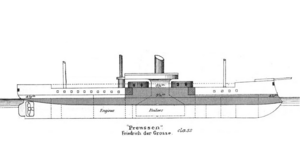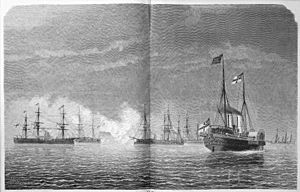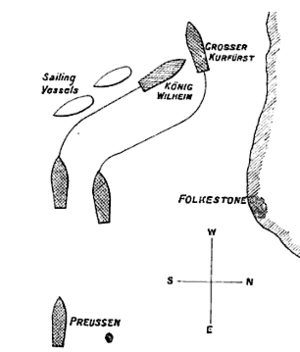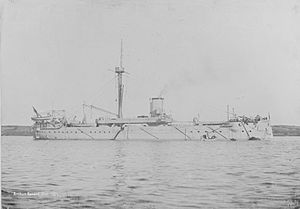SMS Preussen (1873) facts for kids
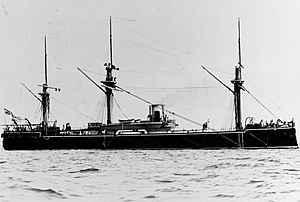
Preussen in 1887
|
|
Quick facts for kids History |
|
|---|---|
| Name | SMS Preussen |
| Namesake | Prussia |
| Builder | AG Vulcan, Stettin |
| Laid down | 1871 |
| Launched | 22 November 1873 |
| Commissioned | 4 July 1876 |
| Decommissioned | 1906 |
| Fate | Scrapped 1919 |
| General characteristics | |
| Class and type | Preussen-class ironclad |
| Displacement | |
| Length | 96.59 m (316 ft 11 in) |
| Beam | 16.30 m (53 ft 6 in) |
| Draft | 7.11 m (23 ft 4 in) |
| Installed power | |
| Propulsion | |
| Sail plan | Full-rigged ship |
| Speed | 14 knots (26 km/h; 16 mph) |
| Range | 1,690 nmi (3,130 km) at 10 kn (19 km/h) |
| Complement |
|
| Armament |
|
| Armor |
|
SMS Preussen was a powerful warship called an ironclad turret ship. It was built for the German Imperial Navy (Kaiserliche Marine). The ship was constructed by the AG Vulcan shipyard in Stettin between 1871 and 1876. It officially joined the fleet in July 1876.
Preussen was special because it was the first large German warship built by a private company. Before this, all big ships were either bought from other countries or built in government shipyards. Its main weapons were four large 26 cm guns. These guns were placed in two gun turrets located in the middle of the ship.
Preussen served in the fleet from when it was built until 1891. It often went into reserve, meaning it was kept ready but not actively used. The ship sailed to the Mediterranean Sea many times. One important trip was in 1877 when there was trouble in the Ottoman Empire. This trip aimed to protect German citizens living there.
After 1891, the ship was taken out of active service. It became a guard ship in the harbor until 1896. Then, it was used as a supply ship in Wilhelmshaven. Later, it became a coal hulk, which is an old ship used to store coal for smaller ships like torpedo boats. In 1903, its name was changed to Saturn. This allowed the name Preussen to be used for a new battleship. The old ship was finally sold and taken apart in 1919.
Contents
Building and Design of the Ship
The Preussen-class ironclads were planned as part of a naval program in 1867. This program aimed to make the German navy stronger. It was needed after the Second Schleswig War, when the small Prussian Navy struggled against the Danish Navy. These ships were first designed as "casemate ships" but were later changed to "turret ships." They were the first group of similar ironclads built for the German fleet.
Preussen was about 96.59 meters (316.9 ft) long from end to end. It was 16.30 m (53.5 ft) wide and had a draft of 7.12 m (23.4 ft) (how deep it sat in the water). The ship was powered by one steam engine that turned a single screw propeller. Six coal-fired boilers created the steam, which went out through one large funnel.
The ship could reach a top speed of 14 knots (26 km/h; 16 mph). It also had a full set of sails. The crew usually included 46 officers and 454 enlisted sailors.
Ship's Weapons and Armor
Preussen had a main set of four 26 cm guns. These were placed in two gun turrets in the middle of the ship. When it was first built, it also had two 17 cm guns, one at the front (bow) and one at the back (stern).
Later, between 1888 and 1890, the ship's weapons were updated. It received more guns, including six, and later ten, 8.8 cm quick-firing guns. It also got a few machine guns and five 35 cm torpedo tubes. These torpedo tubes were hidden inside the ship's hull, below the waterline.
The ship's armor was made of strong wrought iron with thick teak wood behind it. The main armor belt around the ship's side had two layers. The top layer was 203 mm (8 in) thick. The bottom layer varied from 102 to 229 mm (4 to 9 in) thick. Both layers had 234 to 260 mm (9.2 to 10.2 in) of teak backing. The gun turrets had 203 to 254 mm (8 to 10 in) of armor on their sides, also with 260 mm of teak behind it.
Service History
Building and Early Years (1871–1878)
The building of Preussen started in 1871. This was after the Franco-Prussian War ended. It was the first time a private German company built a large warship for the navy. The ship was launched on 22 November 1873. Crown Princess Victoria officially named the ship.
After being built, Preussen was towed to Swinemünde in November 1875. It was officially commissioned into the German fleet on 4 July 1876. Then, it moved to Kiel to have its guns installed. Even though it was the last ship in its class to start building, it was the first to be launched and join the fleet. This was because it was built by an experienced company, while its sister ships were built by newer government shipyards.
In late 1876, the ship began its sea trials (tests). These tests were paused in early 1877. This was because Preussen had a strong hull and was used to break ice in the Baltic Sea for merchant ships. The trials finished in May 1877.
Soon after, Preussen joined the Ironclad Squadron. This squadron, led by the flagship Kaiser, sailed to the Mediterranean Sea in May 1877. There was unrest in the Ottoman Empire due to the Russo-Turkish War. The German ships went to protect German citizens. They visited ports like Haifa and Jaffa. The squadron returned to Germany in October. On the way back, Preussen was damaged by bad weather. It needed repairs after arriving back in Germany.
In April 1878, Preussen took part in fleet exercises. Its two sister ships, Friedrich der Grosse and Grosser Kurfürst, also joined. The Ironclad Squadron then planned a training trip to the Mediterranean. On 29 May, while sailing through the English Channel, an accident happened. The armored frigate König Wilhelm accidentally crashed into Grosser Kurfürst. Sadly, Grosser Kurfürst quickly sank, and 276 men were lost.
Preussen did not immediately help with the rescue. Instead, it sailed in a wide circle before stopping some distance away. It only picked up two men who had already been rescued by a British fishing boat. Preussen then took the damaged König Wilhelm to Portsmouth for emergency repairs.
After this accident, the Mediterranean trip was canceled. The yearly summer exercises for 1878 were also canceled. Preussen took naval cadets on a short training trip in the Baltic Sea. It also went on a training trip with Prince Heinrich of Prussia aboard. On 9 November, Preussen was taken out of service for the winter.
Active Years and Modernization (1879–1888)
On 5 May 1879, the armored squadron was active again. It included Preussen, her sister ship Friedrich der Grosse, and two older armored frigates. The main summer training trip was mostly in the Baltic Sea, with a short visit to Norway. During this trip, the ships visited Russia and met Tsar Alexander III. After returning to Germany, Kaiser Wilhelm I visited them. Preussen was also used to tow a new floating dry dock. The ships returned to Kiel in September and were put into reserve for the winter.
On 3 May 1880, Preussen was reactivated to serve with the Ironclad Squadron. The squadron stayed in the Baltic Sea for its summer trip, except for a short visit to Wilhelmshaven. During exercises in July, important leaders like Crown Prince Friedrich and his son, Prince Wilhelm, visited Preussen.
The summer trip in 1881 was similar. In July, the German ships hosted a visit from the British reserve squadron, which included the first British ironclad, HMS Warrior. Preussen and the squadron visited Danzig in September.
Preussen was active from May to September in 1882. The summer trip included the same four ironclads as the previous year. Starting in 1883, Preussen was kept in reserve during the yearly summer exercises. This was because newer ships were joining the fleet.
From 1883 to 1884, the ship went through a major update. It received new boilers and a rebuilt back deck (poop deck). Its sailing rig (masts and sails) was also made smaller. More updates happened starting in 1885. Two 37 mm Hotchkiss guns and five hidden torpedo tubes were added. This work finished on 4 November 1888. The ship was then assigned to a new Reserve Division.
Final Years of Service (1889–1919)
Preussen was put back into service on 1 May 1889 to join the yearly summer training program. In August, Preussen took part in Kaiser Wilhelm II's first visit to Great Britain. The ship was part of II Division, which also included its sister ship Friedrich der Grosse. The fleet then did exercises in the North Sea before returning to Germany.
Preussen and II Division became the Training Squadron for the fleet in 1889–1890. This was the first time the German Imperial Navy had an ironclad force active all year. The squadron escorted Kaiser Wilhelm II's yacht to the Mediterranean. This trip started on 30 August and included visits to Italy and the Ottoman Empire. The squadron stayed in the Mediterranean until spring 1890, returning to Germany on 22 April.
Preussen returned to the Training Squadron. In June, it escorted the Kaiser on a visit to Christiana, Norway. The ship was also present when the island of Helgoland was officially transferred from British to German control in 1890. It took part in fleet exercises in September. Here, the eight-ship armored squadron pretended to be a Russian fleet blocking Kiel.
II Division, including Preussen, served as the training squadron in the winter of 1890–1891. The squadron again sailed to the Mediterranean. This trip started on 12 November and ended on 18 April 1891. After returning to Germany, Preussen had a big overhaul. It was put back into service in mid-May 1891 for a final round of fleet exercises. After the training year ended, it was taken out of service for the last time on 9 October. It became a harbor guard ship at the end of 1891.
From January to July 1893, the ship was part of the Reserve Division. It was based in Wilhelmshaven as a harbor ship starting in November 1896. Its name was changed to Saturn on 12 November 1903. This was so its original name could be used for the new battleship Preussen.
The ship was officially removed from the navy's list on 21 May 1906. It was then used as a coal hulk for torpedo boats. As a hulk, Saturn could hold up to 5,000 t (4,900 long tons; 5,500 short tons) of coal. It was finally sold for scrap on 27 June 1919 and taken apart that same year in Wilhelmshaven.
Today, parts of the ship are on display in museums. Its figurehead (a carved decoration from the front of the ship) is in the Militärhistorisches Museum der Bundeswehr in Dresden. Its bow ornament (another decoration from the front) is in the Deutsches Museum in Munich.


